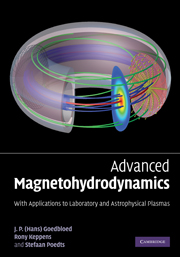12 - Waves and instabilities of stationary plasmas
Published online by Cambridge University Press: 05 March 2013
Summary
Laboratory and astrophysical plasmas
Grand vision: magnetized plasma on all scales
In Chapter 1 of the preceding Volume [1] we pointed out that, since more than 90% of visible matter in the Universe is plasma, the dynamics of plasmas and the associated magnetic fields are an important constituent of the description of nature. In Chapter 4 [1], we then showed that the equations of magnetohydrodynamics (MHD) are scale-independent: the scales of length, density and magnetic field strength of a magnetically confined plasma may be divided out. This simple fact has the amazing consequence that the macroscopic dynamics of plasmas in both laboratory fusion devices (tokamaks, stellarators, etc.) and astrophysical objects (stellar coronae, accretion disks, spiral arms of galaxies, etc.) may be described by the same equations, viz. the equations of MHD. We encountered several examples of this before, in Volume [1]. In the present Volume [2], we will continue the investigation of this common field of research by means of the new “wide-angle MHD telescope”.
Figure 12.1 shows two representative, but very different, examples from science and technology, viz. the design drawing of the international tokamak experimental reactor ITER, presently under construction, and an image made by the Hubble Space Telescope of the Pinwheel Galaxy M101. The consequence of scaleindependence is that the most obvious difference of the two configurations, their length scale indicated next to the figure, is actually irrelevant for the description of macroscopic plasma dynamics!
- Type
- Chapter
- Information
- Advanced MagnetohydrodynamicsWith Applications to Laboratory and Astrophysical Plasmas, pp. 3 - 48Publisher: Cambridge University PressPrint publication year: 2010



